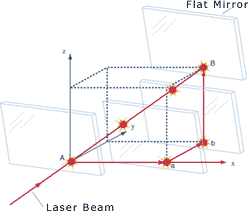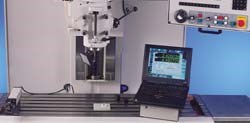Improving Productivity With Calibration
Shop managers have understood the benefits of volumetric calibration and compensation of machine tools for a while, but the technique rarely has been used because it has been too expensive and too complicated.
Shop managers have understood the benefits of volumetric calibration and compensation of machine tools for a while, but the technique rarely has been used because it has been too expensive and too complicated. Optodyne, Inc., of Compton, California, is now offering a volumetric calibration and compensation system that can do volumetric calibration and compensation of a single machine in about 2 to 4 hours. Optodyne officials compare this to other methods that typically take 2 business days for volumetric calibration of a machine tool, with linear calibration often requiring a full 8 hours.
This system, consisting of the MCV-500 laser calibration equipment and SD-500 Vector measurement software, is priced in the $13,000 range, making it affordable for many medium sized shops.
According to Optodyne, a regularly calibrated machine ensures high repeatability. If the machining process is correct, the parts are correct—all of the parts. And this translates into higher productivity and cost-effectiveness. So the bottom line is driving the trend toward regular volumetric calibration and compensation of metalworking machines, Optodyne officials say.
At the heart of Optodyne's calibration system is Laser Doppler Displacement Meter technology. The system measures linear position errors, vertical straightness errors and horizontal straightness errors for all three linear axes. It also measures three squareness errors. When a machine tool's volumetric errors are measured, it can be compensated over the whole volume, which improves the overall accuracy of the machine tool, not simply its linear displacement, developers say. The Optodyne system can determine volumetric accuracy with only four body diagonal displacement measurements. According to the company, body diagonal displacement errors are sensitive to all the volumetric error components and therefore make an efficient test of volumetric accuracy.
The system needs four setups to detect nine sets of errors, based on efficient measurement of body diagonals. The working volume of a typical VMC has eight body diagonals, a diagonal being defined by starting at one corner of the base plane and moving to the opposite corner at the top plane. The positive or negative axis movement defines these body diagonals. The last four body diagonals are the same corners as the first four diagonals, except the directions are reversed.
Hence there are only four body diagonal directions with forward movement and reverse movement (bi-directional), and there are only four setups.
For each setup, the machine spindle movement along each of the diagonals is measured by first executing the X, then the Y, and finally the Z portion of the spindle travel. Readouts are taken and recorded at each intermediate step. This method demonstrates how three displacement errors, three vertical straightness errors and three horizontal straightness errors are measured with only four setups. For this reason, a three-axis machine tool with a one-meter cube volume can be checked in about 4 hours.
In many applications, fixtures and tooling do not have to be removed, and enclosures do not have to be dismantled. According to the company, the system is designed so that it can be set up and operated by shop floor personnel, with two to three hours needed to learn how.
By measuring volumetric errors, Optodyne's software can generate a compensation table, which can be downloaded to the control. The table compensates for errors detected in the machine tool's whole volume. Optodyne claims that the gain in accuracy reduces the bandwidth of errors by a factor of four, going from a typical volumetric error of 0.060 mm down to 0.015 mm.
Compensation file formats are available for Giddings & Lewis, Milltronics, Siemens 840, Fanuc 15 and Fanuc 16 controls, with others in development.
The Optodyne laser system is calibrated and traceable to NIST, and software analysis supports various industry standards such as ISO 230-2 and ASME B5.54. To make data collection and analysis easier, the MCV-500 can be connected to most Windows-compatible notebook or desktop computers through an RS 232 port. Windows supported software provided with the system enables automatic collection and analysis of data.
Related Content
7 CNC Parameters You Should Know
Parameters tell the CNC every little detail about the specific machine tool being used, and how all CNC features and functions are to be utilized.
Read MoreUnderstanding G27, G28, G29 and G30
Take a closer look at these reference position commands.
Read More5 G-Code Tips for Increasing CNC Efficiency
Optimizing G code is a low-cost way to improve CNC efficiency without sacrificing usability and safety.
Read MoreWhen to Use Custom Macros With a CAM System
Custom macros can offer benefits even when using a CAM system to prepare programs – but must be implemented with the right considerations.
Read MoreRead Next
The Cut Scene: The Finer Details of Large-Format Machining
Small details and features can have an outsized impact on large parts, such as Barbco’s collapsible utility drill head.
Read More3 Mistakes That Cause CNC Programs to Fail
Despite enhancements to manufacturing technology, there are still issues today that can cause programs to fail. These failures can cause lost time, scrapped parts, damaged machines and even injured operators.
Read More



























